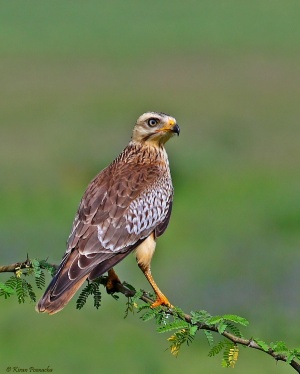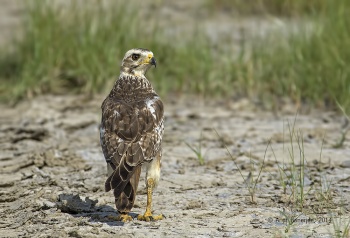- Butastur teesa
Identification
36–43 cm (14-17 in)
- White throat
- Dark cheek stripes
- Brown and white underparts
- Orange-yellow cere
- White or yellowish white eyes
- Whitish nuchal patch
- Buffish wing shoulders
Sexes similar, females slightly larger
Juvenile eyes are brown
Similar Species
Silhouette, of the rounded wings reminiscent of the Shikra.
Distribution
Southern Asia
Breeds in Pakistan, most of India except the far south-west, Nepal, western China, Burma and south to southern Thailand. Resident west Yunnan, Thailand, southern Laos, south Vietnam and Cambodia. Also in south-east Borneo, Sulawesi and Java.
Taxonomy
This is a monotypic species[1].

Photo © by kiran poonacha
Bangalore, Karnataka, India, 24 August 2008
Habitat
Dry, open woodland and scrub, occurring up to 1200m in the Himalayas.
Behaviour
Often seen with larger birds of prey.
Diet
Perches on dry trees, telegraph posts, etc., and swoops down on its prey.
The diet consists of small mammals, locusts, grasshoppers, crickets and other large insects as well as mice, lizards, crabs and frogs.
Breeding
The breeding season runs from February to June. Both sexes build a loose, unlined cup of twigs in the fork of a thickly foliaged tree. The clutch consists of 3 greenish-white eggs which is incubated by the female. Both parents feed the young.
Movements
Basically a resident species with some local movements.
Vocalisation
Call: A plaintive mewing, usually uttered when pairs soar in circles high up in the air.
References
- Clements, J. F., T. S. Schulenberg, M. J. Iliff, D. Roberson, T. A. Fredericks, B. L. Sullivan, and C. L. Wood. 2014. The eBird/Clements checklist of birds of the world: Version 6.9., with updates to August 2014. Downloaded from http://www.birds.cornell.edu/clementschecklist/download/
- Handbook of the Birds of the World Alive (retrieved July 2015)
- The Beauty of Birds
Recommended Citation
- BirdForum Opus contributors. (2024) White-eyed Buzzard. In: BirdForum, the forum for wild birds and birding. Retrieved 9 November 2024 from https://www.birdforum.net/opus/White-eyed_Buzzard
External Links
GSearch checked for 2020 platform.1






